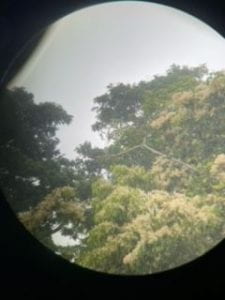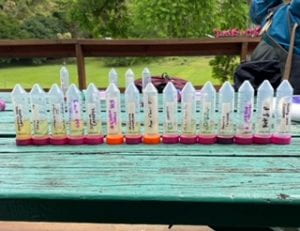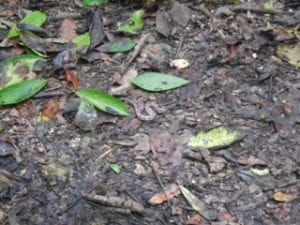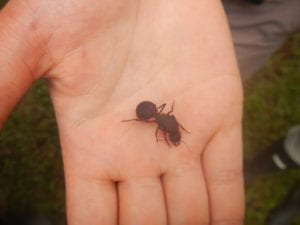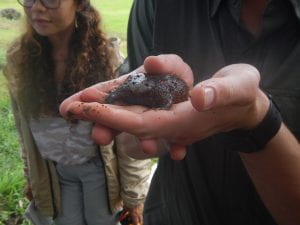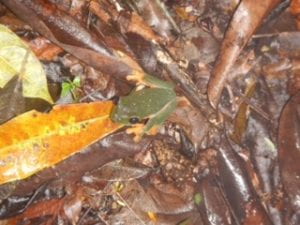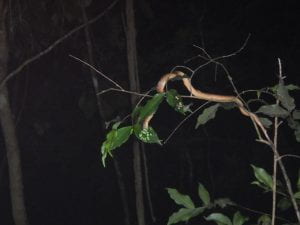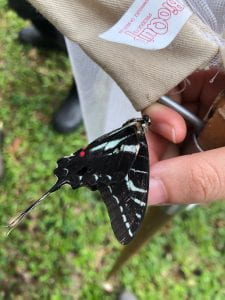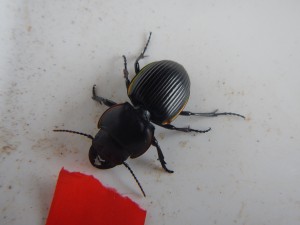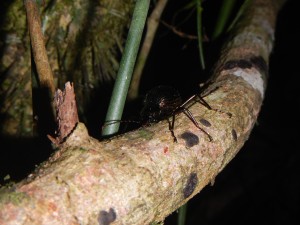This morning, Elise and I discovered that there was definitely maybe a jaguar (or some other feline-y mammal) strolling around our cabin. Last night, when we were frolicking around the clearing of grass around our cabin, trying to spot stars whenever the stubborn clouds parted, we smelled a bold whiff of something like cat pee. As soon as our nostrils made us suspicious, we fell silent. Then, we heard a few twigs snap and RACED back up the stairs to our safe cabin deck, saving the jaguar spotting for another night. Debriefing with Dr. Evans this morning, we learned that he also heard a deeep mammal exhale right outside of his room around that time.
With coffee and tea in hand, sitting around the picnic tables on the deck, we listened to our reliable grackle friend (he’s there all day, every day) squawk and put on a scene for the ladies. Down on the grass, Lonesome George (a flamboyant, wild turkey, who doesn’t mind being alone so that all eyes are on him) was roaming around. He’s extra flashy with an undercoat of black and white checkered feathers, some iridescence on his top coat, and quite a few more patterns. Also, we found a bunch of turkey feathers in a spot along the trail and think a jaguar got to his friend.

(Lonesome George – 05/20/25)
Today we would be designing and executing another research project, this time, using our pee for an experimental treatment. Often, most of the rainforest’s nitrogen is stored near the forest floor in the decomposing leaf litter and nitrogen-fixing bacteria (organisms that live in the soil and convert atmospheric nitrogen into forms usable by plants). As you climb higher, nitrogen becomes harder to come by. Therefore, plant-available nitrogen should be more available and more evenly distributed on the forest floor than in the canopy, where occasional, limited nitrogen sources would be more concentrated around the few sources and less common. To test this, we set up pitfall traps, which were just tubes filled halfway with liquid, camouflaged so that insects would stumble in and stay trapped. We would compare the differences in species richness (the number of species), species abundance (the total number of species), and total biomass in the treatments. To make the control and experimental treatment, we filled tubes with water (no nitrogen) and pee (yes nitrogen) hidden in the forest floor (in the soil) and on tree trunks. We peed in tubes, put on our boots, and headed out for the rainforest.

(Tree Pee Tubes – 5/19/25)
Before we headed out, we were given 2 pieces of advice for the field:
- Dr. Evans: “Make sure you guys bring your childlike whimsy with you.”
- Dr. Solomon: “Watch out for killer ants.”
About the killer ants, apparently not too long ago (around the 90s), scientists decided to breed the European honey bees (with low honey production and low agressiveness) with African Honey Bees (with high honey production and high agressiveness) with the hopes of creating a high honey and low agressiveness phenotypic combination and a winning bee vareity for market honey production. Instead, they created the opposite–a low-honey, high-aggressiveness bee. Not only is this meany more aggressive, but it also has a lower threshold (it will react with less disturbance/irritation) for sending a warning call back to the hive to bring the other bees over. So, contact with one hybrid bee could summon the killer bees. 6 of these hybrids (specifically queen bees) escaped the lab, and now, 30ish years later, they’re taking over the rainforests.
While setting our traps, we stopped to chat about some more insects that can do some damage. We walked on top of this humongous leaf-cutter ant hill (literally hill-sized), and some of the pinky-sized, pinch-armed soldier ants (the specialized protectors of the colony) came out to greet us. One of us turned around and saw a soldier making its way up Ian’s back. While everyone was panicking and working together to whack it off, Dr. Solomon popped by and said, “So guys, that was a great example of social grouping in primates. All you have to do now is eat the ant.” Yep, classic Dr. Solomon. Learning by doing, ya know?

(Leaf-cutter Soldier – 05/19/25)
After this little morning project and a delicious lunch from our exceptional chef Angie (nothing can compare to the plantains here), we strategized for rainforest study 3, which did not involve urine, but rather catching crickets and ravaging ant colonies :(. There are these trees called Cecropia trees, which are layered with chambers like a “high-rise apartment complex” that mutually host Azteca ants. The ants protect the tree from predators, and the tree excretes sugary, nutritious meals for the ants in return.
DSCF1315 (Cecropia-ant Mutualism – 05/19/25)
In our project, we were examining how the presence of the ants changes the tree’s physical and chemical composition (specifically its defense systems) in its leaves. We would collect leaves from two Cecropia trees–one with ant symbionts and one without–and compare the strength and herbivory amounts of the leaves. We had a fancy penetrameter to measure the force it would take to break through a leaf, and Dyllan brought out her butterfly net so that we could catch some herbivorous insects to consume the leaves.
You know us, and we stopped many times during the search for Cecropia trees to poke sticks in freshly webbed-covered tarantula holes. When finally one popped out, the whole class exclaimed “OH!” and jumped back in unison. Also, did you know spider hairs are also irritating in addition to their venomous fangs? Their hairs are barbed and urticating, meaning they cause irritation and discomfort upon contact (https://enviroliteracy.org/animals/are-tarantulas-hair-poisonous/).
Today was a bug-heavy day, completed with a scorpion sighting in our classroom drawer. My takeaways: insects are very diverse, have a few defense tricks up their sleeves (their 6 or 8 sleeves), and are mind-boggingly complex. Tomorrow, we’re learning more about leaf-cutter ants, so stay tuned for more insect lore.












